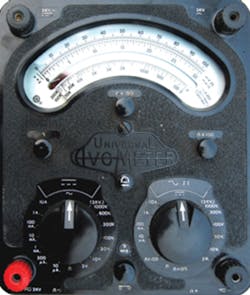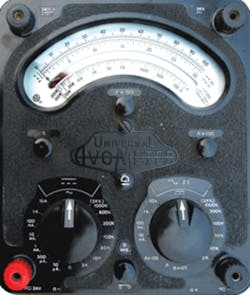In the hands of a trained operator, an analog multimeter had sufficient resolution and accuracy for most applications in the 1950s and 1960s. A mirrored movement helped you correctly align the meter’s pointer with the scale graduations. Of course, sometimes the pointer would be between two marks so you might record a high or low value or perhaps take a guess at some mid-range amplitude. And, occasionally, even a trained operator might blow up a meter by having it on the wrong range.
Photographer: Russell W. Barnes, I.Eng., MIET
Digital multimeters (DMMs) solved the repeatability problem by presenting the measured value as unambiguous digits. The earliest DMMs had to find solutions to issues such as range and polarity switching, analog-to-digital conversion, and even the display of the measured value. One of the first DMMs, Fairchild Instrumentation’s 4½-digit Model 7100 with 0.01% accuracy and a dual-slope integrating ADC, was advertised in EE’s 1966 March/April issue.
Accounts of the subsequent demise of Fairchild during the 1970s may be required reading for business majors but insufficiently acknowledge the importance of the dual-slope technique the company had invented. The Hewlett-Packard Model 405C DMM based on a less accurate single-slope voltage-to-time conversion method was developed a few years earlier. In addition to greater accuracy and stability, the dual-slope scheme had the advantage of canceling AC mains noise and still is used today.
Only a few DMM ads ran during the 1960s and 1970s, reflecting the magazine’s reliability and evaluation engineering theme. In the March/April 1979 issue, Beckman advertised the Model 3020 3½-digit instrument. This was one of the first handheld DMMs and sold for $170. For an extra $20, you could add true rms AC measurements.
By the late 1970s, many types of digital instruments had been developed. HP ran the same ad on the inside front cover of EE for more than a year, showing a group of several instruments, including a DMM, all with digital readouts. Nevertheless, it wasn’t until the mid 1980s that EE featured a large number of instruments in the editorial calendar. The first DMM guide ran in January 1985, followed by another in the February 1986 issue and most February issues thereafter.
The 1987 guide listed products from eight companies, many only memories today: Solartron Instruments Model 7061, Keithley Instruments Model 194, John Fluke Manufacturing Model 37, Philips Test and Measuring Instruments Model 2535, Beckman Model DM23, North American Soar D2M2 Series, Datron Instruments DMM with autocal, and Prema Precision Electronics Model 6031.
By the time the1990 guide was published, the list of players and the instruments they provided had changed considerably. Several Asian DMM companies including Goldstar Precision and Kyoritsu Electrical Instruments had established stateside distribution. HP was selling a range of handheld models as were most of the other manufacturers. And, within a single company such as Fluke, the product line already had become diversified to handle different market segments: low cost, high energy, field service, and precision measurements.
Throughout the 1990s and 2000s, EE continued to publish a DMM guide each February and often a more focused DMM story later in the year. During this time, VXI and PXI test systems gained prominence, and many articles addressed the modular DMMs they use. Signametrics’ Tee Sheffer contributed expert advice that helped readers understand the detailed interaction between a high-precision DMM and the signal switching within an ATE application. Articles from Keithley, HP and Agilent Technologies, and Wavetek Meterman also were published.
Much of the functionality we take for granted today was introduced in the very early DMMs. For example, the 1963 HP Model 405C was auto-ranging. The Philips 2×18 Series DMMs featured an analog bar graph display in 1987. Solartron and Prema Precision both offered closed-case calibration also in 1987.
Interestingly, it wasn’t until the mid 1980s that the “half” as in 3½-digit became consistently used. The Fairchild 7100 was described as having 4 digits plus 50% overrange in 1966, and even in 1987, Philips listed the 2×18 Series as having 4+ digits.

